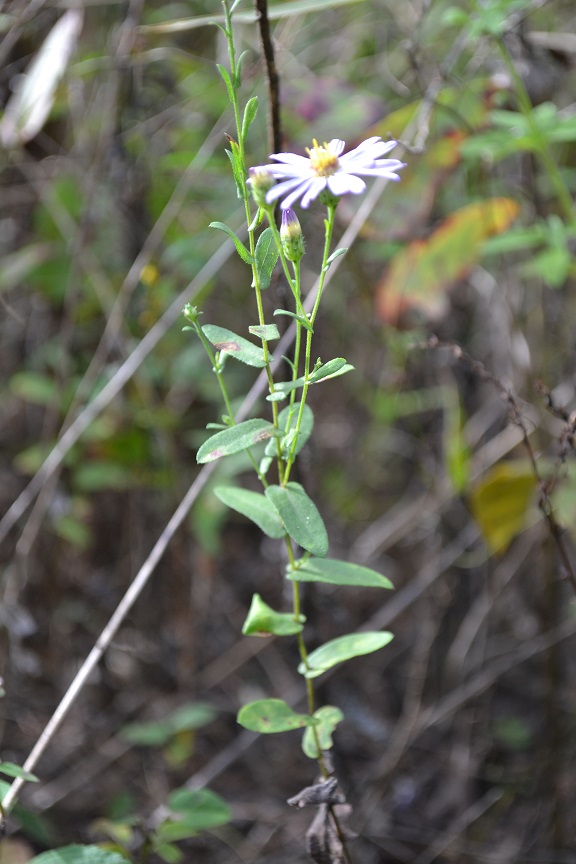Difference between revisions of "Symphyotrichum patens"
(→Conservation and Management) |
Krobertson (talk | contribs) |
||
| Line 28: | Line 28: | ||
==Ecology== | ==Ecology== | ||
===Habitat=== <!--Natural communities, human disturbed habitats, topography, hydrology, soils, light, fire regime requirements for removal of competition, etc.--> | ===Habitat=== <!--Natural communities, human disturbed habitats, topography, hydrology, soils, light, fire regime requirements for removal of competition, etc.--> | ||
| − | This species can live in humid, subtropical climates in drying sandy loam on the edges of woodland remnants, shade of mesic woodlands, xeric limestone prairies, open old-field pine woods, and sandy clay of the Red Hills | + | This species can live in humid, subtropical climates in drying sandy loam on the edges of woodland remnants, shade of mesic woodlands, xeric limestone prairies, open old-field pine woods, and sandy clay of the Red Hills. <ref name="Burton 2009">Burton, J. A. (2009). Fire frequency effects on vegetation of an upland old growth forest in eastern Oklahoma. Environmental Science. Stillwater, Oklahoma, Oklahoma State University. Bachelor: 78.</ref> <ref name="FSU Herbarium">Florida State University Robert K. Godfrey Herbarium database. URL:[http://herbarium.bio.fsu.edu http://herbarium.bio.fsu.edu]. Last accessed: June 2014. Collectors: Loran C. Anderson, Angus Gholson Jr., R. Kral, Robert K. Godfrey, Angela M. Reid, K. M. Robertson, Ann F. Johnson, and Wilson Baker. States and Counties: Florida: Gadsden and Leon.</ref> <ref name="McCain and Ebinger 2014">McClain, W. E. and J. E. Ebinger (2014). "Vascular Flora of Buettner Xeric Limestone Prairies, Monroe County, Illinois." Southern Appalachian Botanical Society.</ref> It can live in communities dominated by post oak as well. <ref name="Burton 2009"/> This species is also found in disturbed habitats such as upland pine-hardwoods, partially wooded vacant lots, and beside trail edges. <ref name="FSU Herbarium"/> Associated species include ''Pinus echinata, Schoenus nigricans, Solidago odora, Callicarpa americana, Myrica cerifera, Liquiambar styraciflua,'' and ''Rhus copallinum.'' <ref name="FSU Herbarium"/> |
===Phenology=== <!--Timing off flowering, fruiting, seed dispersal, and environmental triggers. Cite PanFlora website if appropriate: http://www.gilnelson.com/PanFlora/ --> | ===Phenology=== <!--Timing off flowering, fruiting, seed dispersal, and environmental triggers. Cite PanFlora website if appropriate: http://www.gilnelson.com/PanFlora/ --> | ||
| − | This species flowers and fruits between October and November | + | This species flowers and fruits between October and November. <ref name="FSU Herbarium"/> |
<!--===Seed dispersal===--> | <!--===Seed dispersal===--> | ||
<!--===Seed bank and germination===--> | <!--===Seed bank and germination===--> | ||
===Fire ecology=== <!--Fire tolerance, fire dependence, adaptive fire responses--> | ===Fire ecology=== <!--Fire tolerance, fire dependence, adaptive fire responses--> | ||
| − | Burton found that the percent cover of S. patens showed a positive linear response to increased fire frequency | + | Burton found that the percent cover of S. patens showed a positive linear response to increased fire frequency. <ref name="Burton 2009"/> |
<!--===Pollination===--> | <!--===Pollination===--> | ||
<!--===Use by animals===--> <!--Herbivory, granivory, insect hosting, etc.--> | <!--===Use by animals===--> <!--Herbivory, granivory, insect hosting, etc.--> | ||
| Line 49: | Line 49: | ||
==References and notes== | ==References and notes== | ||
| − | |||
| − | |||
| − | |||
| − | |||
| − | |||
| − | |||
Revision as of 13:03, 9 August 2016
| Symphyotrichum patens | |
|---|---|

| |
| Photo by Kevin Robertson | |
| Scientific classification | |
| Kingdom: | Plantae |
| Division: | Magnoliophyta – Flowering plants |
| Class: | Magnoliopsida – Dicotyledons |
| Order: | Asterales |
| Family: | Asteraceae ⁄ Compositae |
| Genus: | Symphyotrichum |
| Species: | S. patens |
| Binomial name | |
| Symphyotrichum patens (Aiton) G.L. Nesom | |

| |
| Natural range of Symphyotrichum patens from USDA NRCS Plants Database. | |
Common name: Late purple aster
Contents
[hide]Taxonomic notes
Synonyms: Symphyotrichum patens (Aiton) G.L. Nesom var. patens; Aster patens Aiton var. patens; Virgulus patens (Aiton) Reveal & Keener var. patens
Description
A description of Symphyotrichum patens is provided in The Flora of North America.
Distribution
Ecology
Habitat
This species can live in humid, subtropical climates in drying sandy loam on the edges of woodland remnants, shade of mesic woodlands, xeric limestone prairies, open old-field pine woods, and sandy clay of the Red Hills. [1] [2] [3] It can live in communities dominated by post oak as well. [1] This species is also found in disturbed habitats such as upland pine-hardwoods, partially wooded vacant lots, and beside trail edges. [2] Associated species include Pinus echinata, Schoenus nigricans, Solidago odora, Callicarpa americana, Myrica cerifera, Liquiambar styraciflua, and Rhus copallinum. [2]
Phenology
This species flowers and fruits between October and November. [2]
Fire ecology
Burton found that the percent cover of S. patens showed a positive linear response to increased fire frequency. [1]
Conservation and management
Cultivation and restoration
Photo Gallery
References and notes
- ↑ Jump up to: 1.0 1.1 1.2 Burton, J. A. (2009). Fire frequency effects on vegetation of an upland old growth forest in eastern Oklahoma. Environmental Science. Stillwater, Oklahoma, Oklahoma State University. Bachelor: 78.
- ↑ Jump up to: 2.0 2.1 2.2 2.3 Florida State University Robert K. Godfrey Herbarium database. URL:http://herbarium.bio.fsu.edu. Last accessed: June 2014. Collectors: Loran C. Anderson, Angus Gholson Jr., R. Kral, Robert K. Godfrey, Angela M. Reid, K. M. Robertson, Ann F. Johnson, and Wilson Baker. States and Counties: Florida: Gadsden and Leon.
- Jump up ↑ McClain, W. E. and J. E. Ebinger (2014). "Vascular Flora of Buettner Xeric Limestone Prairies, Monroe County, Illinois." Southern Appalachian Botanical Society.